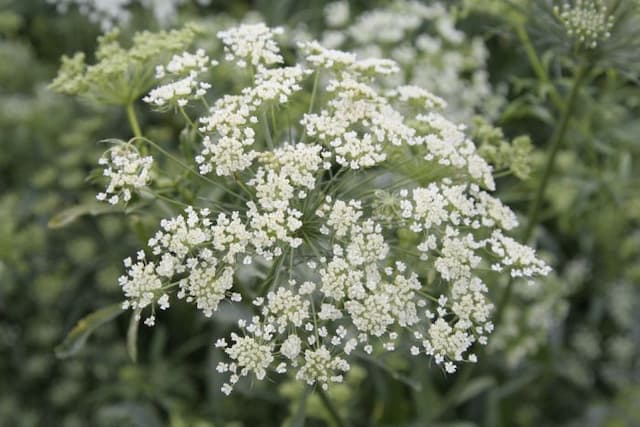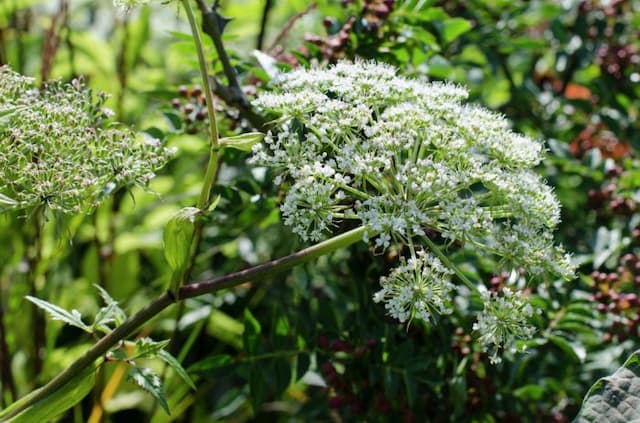Great Masterwort Astrantia 'Hadspen Blood'

ABOUT
Astrantia 'Hadspen Blood', also known as Great Masterwort, is a striking perennial known for its unique and enchanting bloom appearance. The flowers have a distinctive look, reminiscent of pincushions, surrounded by an attractive collar of bracts. These bracts are not true petals but resemble them; they are typically a darker shade of red or burgundy, which provides a dramatic contrast to the tiny, clustered, true flowers at the center. The true flowers are typically a deeper red or even crimson hue, creating a rich and sumptuous display. Great Masterwort's foliage is also noteworthy, comprising deeply lobed, palmate leaves that are a fresh green color. These leaves are notably intricate, forming a mesmerizing mound of foliage that beautifully showcases the plant's vibrant blooms. The overall impression of Astrantia 'Hadspen Blood' is of an elegant and slightly whimsical plant with a color palette that draws the eye and stands out vividly in garden settings. The flowers and foliage together create a texture-rich visual that adds depth and interest wherever it is planted.
About this plant
 Names
NamesFamily
Apiaceae
Synonyms
Great Masterwort, Hattie's Pincushion, Melancholy Gentleman
Common names
Astrantia 'Hadspen Blood'.
 Toxicity
ToxicityTo humans
Great Masterwort 'Hadspen Blood' is not commonly known to be toxic to humans. There are no well-documented cases or specific reports regarding the toxicity of Great Masterwort. However, as with any plant material, individuals may have varying sensitivities or allergic reactions, and it is generally advisable to avoid ingesting plants that are not known to be safe for consumption. If you suspect poisoning or an allergic reaction after ingesting any part of the plant, seek medical attention.
To pets
Great Masterwort 'Hadspen Blood' is not commonly known to be toxic to pets. There is limited information available regarding the toxicity of Great Masterwort to animals, and it does not appear on common lists of poisonous plants for pets. However, as pets can have different sensitivities, it's best to prevent them from consuming plant material not intended for their diet. If you observe any unusual symptoms in your pets after ingestion, such as vomiting, diarrhea, or signs of distress, contact your veterinarian.
 Characteristics
CharacteristicsLife cycle
Perennials
Foliage type
Deciduous
Color of leaves
Green
Flower color
Red
Height
2 feet (0.61 meters)
Spread
2 feet (0.61 meters)
Plant type
Herb
Hardiness zones
5
Native area
Europe
Benefits
 General Benefits
General Benefits- Astrantia 'Hadspen Blood', commonly known as Great Masterwort, is valued for its unique, pincushion-like flower heads, which add an architectural element to garden designs.
- Its deep ruby-red flowers provide a striking color contrast when planted amongst perennials with lighter hues, enhancing the visual appeal of gardens.
- Great Masterwort has a long blooming season, typically from early to mid-summer, offering an extended display of flowers.
- The plant thrives in partial shade, making it a versatile addition to shaded garden areas that need a touch of color.
- It is resistant to many common pests and diseases, reducing the need for chemical treatments in the garden.
- Great Masterwort is popular among pollinators, including bees and butterflies, which help to maintain biodiversity and healthy ecosystems.
- The plant is relatively low maintenance, needing only occasional deadheading and dividing to keep it looking its best.
- It is hardy in a range of climates and can withstand cold temperatures, making it suitable for many different garden settings.
- Astrantia 'Hadspen Blood' works well as a cut flower, adding an unusual and lasting element to floral arrangements.
- It forms clumps that can be easily divided to propagate new plants, offering a cost-effective way to expand garden plantings.
 Medical Properties
Medical PropertiesThis plant is not used for medical purposes.
 Air-purifying Qualities
Air-purifying QualitiesThis plant is not specifically known for air purifying qualities.
 Other Uses
Other Uses- Astrantia 'Hadspen Blood', commonly known as Great Masterwort, can be used as a natural fabric dye, yielding delicate shades of pink or purple depending on the mordant used.
- Great Masterwort's dried seed heads can be used in floral arrangements, where they provide an interesting texture and can last for an extended period.
- The root of Great Masterwort, when crushed, can be used as a natural insect repellent due to its strong aroma that insects tend to avoid.
- This plant can serve as a muse for artists and photographers due to its unique star-shaped flowers and rich, blood-red coloring.
- Great Masterwort leaves can be used as an addition to compost piles, as they break down and contribute valuable nutrients back into the soil.
- The plant can play a role in educational gardens or botanical collections, exemplifying native European flora and pollinator-friendly gardening practices.
- In landscaping, Astrantia 'Hadspen Blood' can be used to create a 'living edge' along pathways, providing a soft, textural boundary that changes throughout the seasons.
- This variety of Great Masterwort can be part of a sensory garden due to its textured leaves and flowers that invite touch and its subtle scent that is noticeable upon close examination.
- Great Masterwort can be used in creative crafts, such as eco-printing, where the leaves and flowers are used to create botanical prints on paper or fabric.
- The stems of Astrantia 'Hadspen Blood' can be used as natural skewers in garden-inspired culinary presentations, adding an unexpected, decorative touch to dishes.
Interesting Facts
 Feng Shui
Feng ShuiThe Astrantia is not used in Feng Shui practice.
 Zodiac Sign Compitability
Zodiac Sign CompitabilityThe Astrantia is not used in astrology practice.
 Plant Symbolism
Plant Symbolism- Protection: Astrantia, also known as Masterwort, is often associated with protection in folklore, believed to ward off evil and negative energies.
- Strength: The robust nature and the longevity of Masterwort blooms symbolize strength and endurance.
- Perseverance: Masterwort's ability to thrive in various conditions reflects the quality of perseverance, suggesting resilience in the face of adversity.
- Mystery: The deep, wine-red color of 'Hadspen Blood' adds an element of mystery and depth to its symbolism, hinting at hidden secrets or the unknown.
- Unity: The intricate umbels of Masterwort, composed of many small flowers, can represent unity and togetherness in diversity.
 Water
WaterGreat Masterwort prefers consistently moist soil, so it should be watered regularly to maintain an even level of moisture, especially during dry periods. Typically, watering once or twice a week with approximately one gallon of water per plant is sufficient, but this depends on the weather and soil conditions. Make sure the water penetrates deeply into the soil to encourage root growth. Frequent, shallow watering should be avoided as it may promote a weak root system. During hot summer months, you may need to water more frequently, while in cooler weather or rainy spells, reduce the amount accordingly.
 Light
LightGreat Masterwort thrives best in partial shade, although it can tolerate full sun in cooler climates. Ideally, it should receive morning sunlight and afternoon shade, which will protect it from the intense heat of mid-day sun. The plant performs well when placed in a location that receives dappled sunlight throughout the day, providing a balance of light and protection.
 Temperature
TemperatureGreat Masterwort is quite cold hardy and can tolerate temperatures down to about 0 degrees Fahrenheit; however, it thrives in temperatures ranging between 50 and 70 degrees Fahrenheit during the growing season. This plant prefers cooler conditions and may not perform well in areas where temperatures consistently exceed 80 degrees Fahrenheit. Providing some shade during the hottest part of the day can help mitigate the effects of high temperatures.
 Pruning
PruningPrune Great Masterwort to remove spent flower stems and encourage additional blooming throughout the summer. Light pruning can be done as needed throughout the growing season to maintain plant shape and promote a tidy appearance. The best time for a more significant cutting back is in late fall or early spring, removing old foliage to make way for new growth.
 Cleaning
CleaningAs needed
 Soil
SoilGreat masterwort prefers fertile, moist, organic-rich soil with a pH range of 5.5 to 7.5. A mix of loamy garden soil, compost, and perlite would enhance drainage and fertility.
 Repotting
RepottingGreat masterwort does not necessarily need frequent repotting and can thrive if repotted every 2-3 years or when it outgrows its container.
 Humidity & Misting
Humidity & MistingGreat masterwort thrives in average to high humidity conditions but is tolerant of a range of humidity levels commonly found in garden settings.
 Suitable locations
Suitable locationsIndoor
Place in bright, indirect light with moist soil.
Outdoor
Plant in partial shade and moist, rich soil.
Hardiness zone
4-7 USDA
 Life cycle
Life cycleAstrantia 'Hadspen Blood', also known as Great Masterwort, begins its life cycle as a seed, requiring a period of cold stratification to break dormancy. Upon germination in early spring, seedlings develop into a rosette of deeply lobed, palmate leaves at the soil surface. The plant establishes a deep root system and by late spring to early summer, the perennial sends up flowering stems bearing intricate, pincushion-like flowers with a deep, reddish-purple hue, surrounded by a ruff of bracts. After flowering, seeds develop and are eventually shed around the plant, contributing to its spread. In the autumn, the above-ground foliage of 'Hadspen Blood' dies back to the ground, with the plant surviving the winter in a dormant state as a rootstock. The following spring, the plant emerges once more, completing its perennial cycle.
 Propogation
PropogationPropogation time
Early spring
Astrantia 'Hadspen Blood', commonly known as Masterwort, is a perennial plant often propagated through division. The ideal time for propagating Masterwort by division is in the spring or early fall when the plant is not in active bloom. This method involves carefully digging up the plant and gently separating the root ball into smaller sections, each with a portion of the root system and several shoots. These divisions can then be immediately replanted at the same soil depth they were originally growing. Water them thoroughly after planting to help establish the new Masterwort plants. This propagation technique is advantageous as it helps to maintain the exact characteristics of 'Hadspen Blood,' ensuring that the distinctive dark red flowers and attractive foliage of the parent plant are preserved in the offspring.








